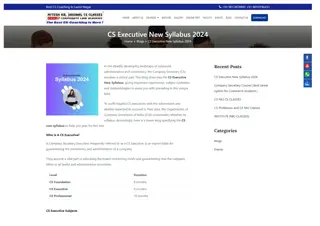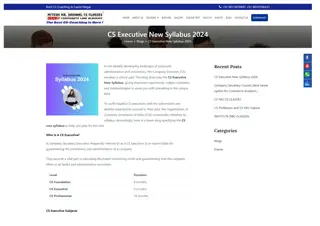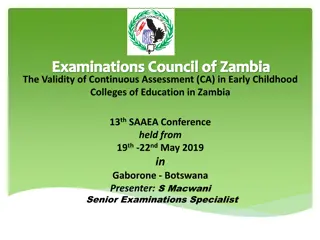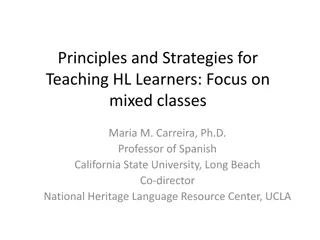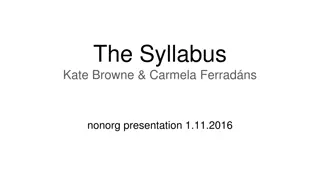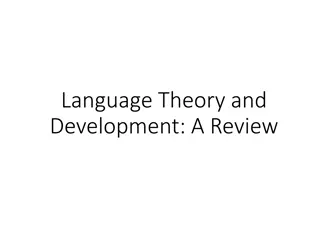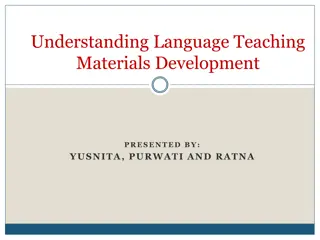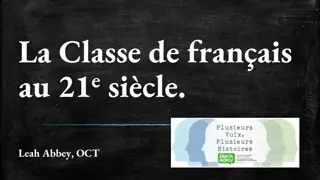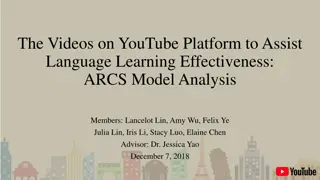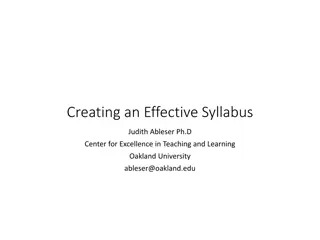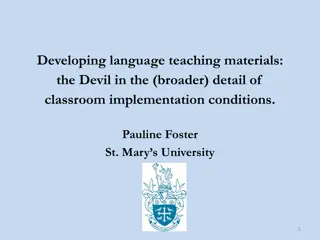Understanding Language Teaching Syllabus: Integration, Theory, and Approaches
Language Teaching Syllabus involves the integration of subject matter and linguistic elements, guided by theories of language and learning. Various approaches like Grammatical, Situational, Communicative, and Analytic are used to structure syllabi. Breaking language into parts aids in sequential learning, leading to language synthesis by learners. Situational Syllabus emphasizes using language in social contexts, considering learner situations and linguistic units. Communicative Syllabus focuses on developing communicative competence through content organization.
- Language teaching
- Syllabus integration
- Language learning theory
- Linguistic approaches
- Communicative competence
Download Presentation

Please find below an Image/Link to download the presentation.
The content on the website is provided AS IS for your information and personal use only. It may not be sold, licensed, or shared on other websites without obtaining consent from the author. Download presentation by click this link. If you encounter any issues during the download, it is possible that the publisher has removed the file from their server.
E N D
Presentation Transcript
Language Teaching Syllabus is an integration of subject matter what to talk about Linguistic matter- how to talk about it Theory of language and theory of learning are essential in syllabus design.
Classification of Approaches SYNTHETIC APPROACHES Grammatical(structural-formal) Syllabus Situational Syllabus Communicative (Functional-Notional) Syllabus ANALYTIC APPROACHES Task Based/Procedural/Project Based Syllabus Topical/Theme-Based Syllabus Skills-Based Syllabus Content-Based Syllabus Cross-Curricular Syllabus Lexical Syllabus Mixed-Layered/Multi-Dimensional Syllabus
Language should be broken into parts so as to teach different parts of language separately and by a step-by- step procedure. Later on, the learner himself/herself build up the language on pieces s/he has been presented. As a result of this gradual accumulation of different parts of language those are thought separately, learners re-synthesis the language.
Situational Syllabus Language is used in a social context and cannot be isolated from the context. The situations that the learner is likely to use should be predicted and the linguistic units for those situations should be taught. The units have situational labels such as at the post office and buying tickets .
The units include the physical context in which interaction occurs; the channel (written or spoken language) of communication the role of the learner in the interaction(addresser or addressee) an the formality of speech
Communicative (Functional- Notional) Syllabus Communicative facts of language are the core of the language. The organization of the syllabus is in terms of content rather than form but without losing the sight of grammatical and situational factors. The goal is to develop communicative competence on the part of the learner so that he can use the target language accurately and fluently in any situation. The labeling of the units is primarily semantic although some structural realization is indicated.
Content selection is related to the needs of learners. It brings linguistic skills and communicative abilities into close association with each other. Examples of functions; informing, agreeing, apologizing, requesting Examples of notions; size, age, color, comparison, time.
COMMUNICATIVE SYLLABUS USE USAGE (what is to be expressed in context) Functions in Coherent Discourse (how the ideas are expressed grammatically) Notions+syntactic Structures The content of the communicative syllabus
While establishing objectives, the needs of the learners need to be analyzed by the various types of communication in which the learners have to confront. Although employing needs analysis implies that the learner is taken into consideration while making decisions about the course, scholars who criticize this approach claim that it is not that different from the structural or situational syllabus design models. They claim that it is a model in which a new list consisting of notions and functions has replaced the old list that contained structural/situational items.
White (1988:77) claims that language functions do not usually occur in isolation and there are also difficulties of selecting and grading function and form. Clearly, the task of deciding whether a given function (persuading) is easier or more difficult than another (approving , makes the task harder to approach. (Rabbini, 2001) Despite the fact that their starting point is different, all these three are listed as syntactic as they all aim to teach one piece at a time. All these focus on the product rather than the process; hence they best serve product oriented curriculum types.
Language is a whole. presented just from the beginning. Much greater variety of linguistic structures is learner. No control in terms of the linguistic input to the deciding on the linguistic content. Structural considerations are secondary while Actual language behavior is structurally very varied. learner. The focus should be on the value of a structure for the
Task Based/Procedural/Project Based Syllabus What is a task? a piece of work undertaken for oneself or for others, freely or for some reward. (painting a fence, dressing a child). In other words, by task is meant the hundred and one things people do in everyday life. (Long 1985:89) an activity or action which is carried out as the result of processing or understanding language (as a response). For example, drawing a map while listening to an instruction and performing a command A task usually requires the teacher to specify what will be regarded as successful completion of the task. (Richards, Platt, and Weber 1985:289)
Language learning can only be accomplished through practice and interaction. TB uses tasks (goal-directed, to accomplish a goal, and activities to encourage the learners use the language communicatively in order to achieve a goal. Tasks must be relevant to the real world language needs of the student.
Tasks may be linguistic (reading job ads, making appointments, filling out a job application) or non- linguistic (making a puppet, coloring a picture). functions and unpredictableway, ,in completing the tasks. Learners draw on a variety of language forms, skills, often in an individual and the learner is expected to perceive the language subconsciously while consciously solving the meaning behind the tasks. By using information- and opinion gap activities concentrating on
Topical/Theme-Based Syllabus * It is similar to situational syllabus. However, it is organized by topics or themes rather than situations. * The authordecides on the topics. * Sample topics of this type of syllabuses are as divorce *terrorism *crime and punishment *stress *food and drinks.
The topics are often sequenced on the basis of their perceived importance or on the basis of relative difficulty of involved. the reading passages theme to activate the already existing knowledge or form a new knowledge area in the schemata of the learner so that the learner can easily learn the language. The underlying idea is to use one topic or
Skills-Based Syllabus The author arranges activities around the language or study academic skills which he thinks the learners will most need in order to use and continue to learn the language. The main idea is to teach and improve skills in order to increase learner s independence (autonomy). A reading course may include the following skills: skimming a text for the general idea, scanning a text for a specific information, guessing vocabulary from the context.
Content-Based Syllabus language that the students are also learning. ( a science class taught in English) The students are both language students and students of whatever content is being taught. However, the subject matter is primary and language learning occurs incidentally to the content learning. Language teaching is organized around the content teaching. Content-based language teaching is concerned with information whereas task-based language teaching is concerned with communicative and cognitive processes. It aims to teach a content or information using the
Cross-Curricular Syllabus It is similar to content-based syllabus. The teacher needs to subordinate herself/himself and her/his discipline to the concerns and needs of the disciplines with which s/he works. The learner may be asked to write lab reports, lab notebooks, abstracts, journal articles, prepare maps The product is for another course in the curriculum such as Geography, Mathematics or Science from which the background knowledge comes.
Lexical Syllabus It can be derived from a detailed analysis of a carefully selected corpus of language that reflects-as much as possible- the language of the target discourse community. Syllabus designer should make the most frequent words, their meaning and information about their typical grammatical and lexical environments; collocations and patterns that words occur in.
A lexical syllabus includes grammar which is identified through the common words those make up common patterns) and expressions of notions and functions but the organizing principle is lexical. It can account for a far higher proportion of text and offer a more through coverage of the language than other syllabus types. collocations, it is clear, unambiguous and accessible. With its inventory of words with their
MIXED-LAYERED/MULTI-DIMENSIONAL SYLLABUS Since the aim is to promote the learner s ability to use the language correctly and appropriately, all types of syllabuses can be integrated by bringing the strengths of all of them together. sensitive to the various student language needs. This kind of syllabus will be less rigid and more
1. Ersz, Aydan. Materials Evaluation and Design. Classpack 2. Nunnan, David. (1988) Syllabus Design, OUP. NewYork 3. Dubin,Fraida &Olshtain, Elite. (1988).Course Design. CUP. Cambridge 4. Wilkins, D.A (1976)Notional Syllabuses. OUP. Oxford 5. Munby, John. (1978) Communicative Syllabus Design. CUP. Cambridge



